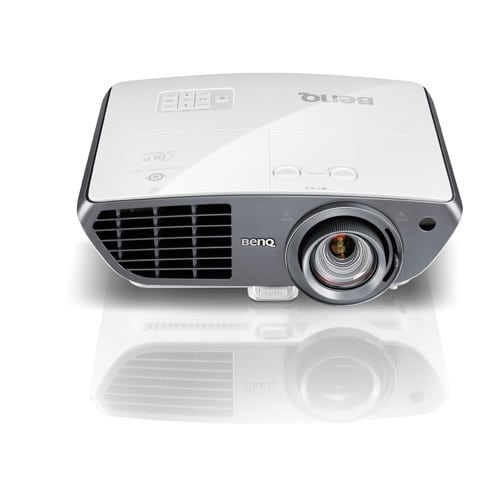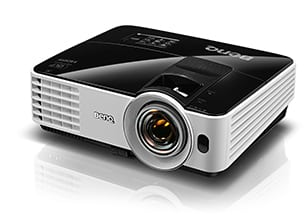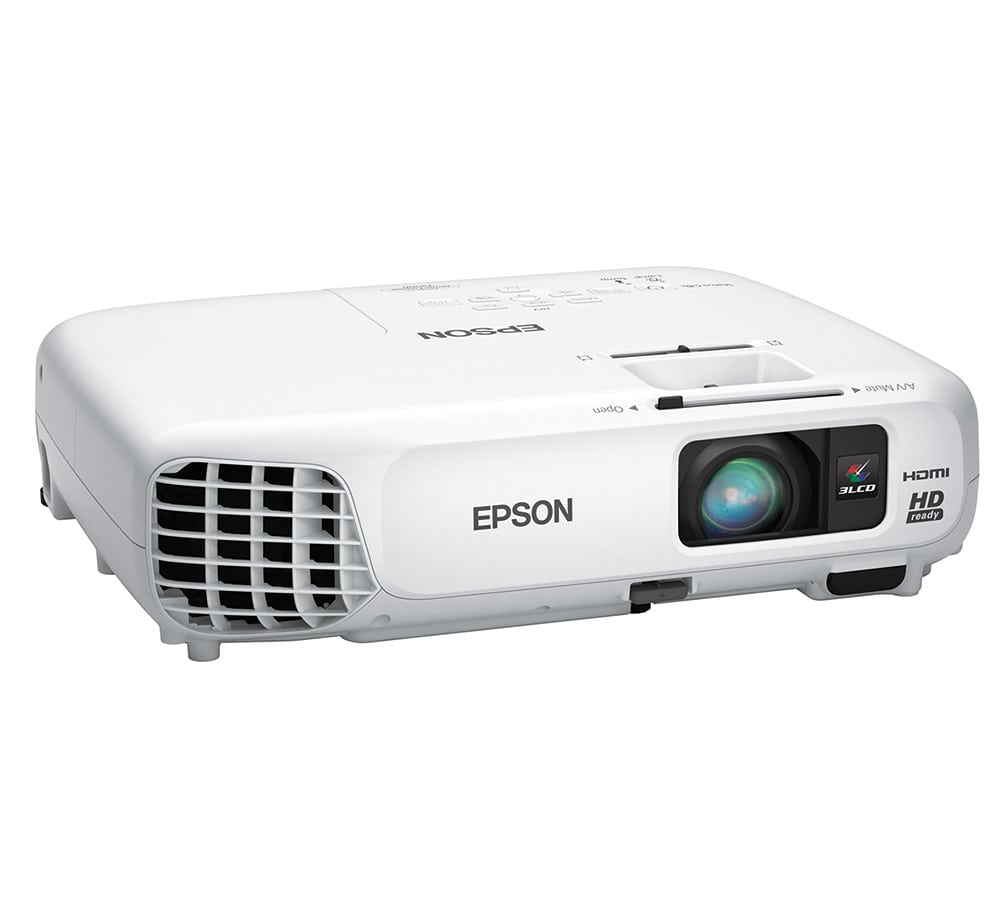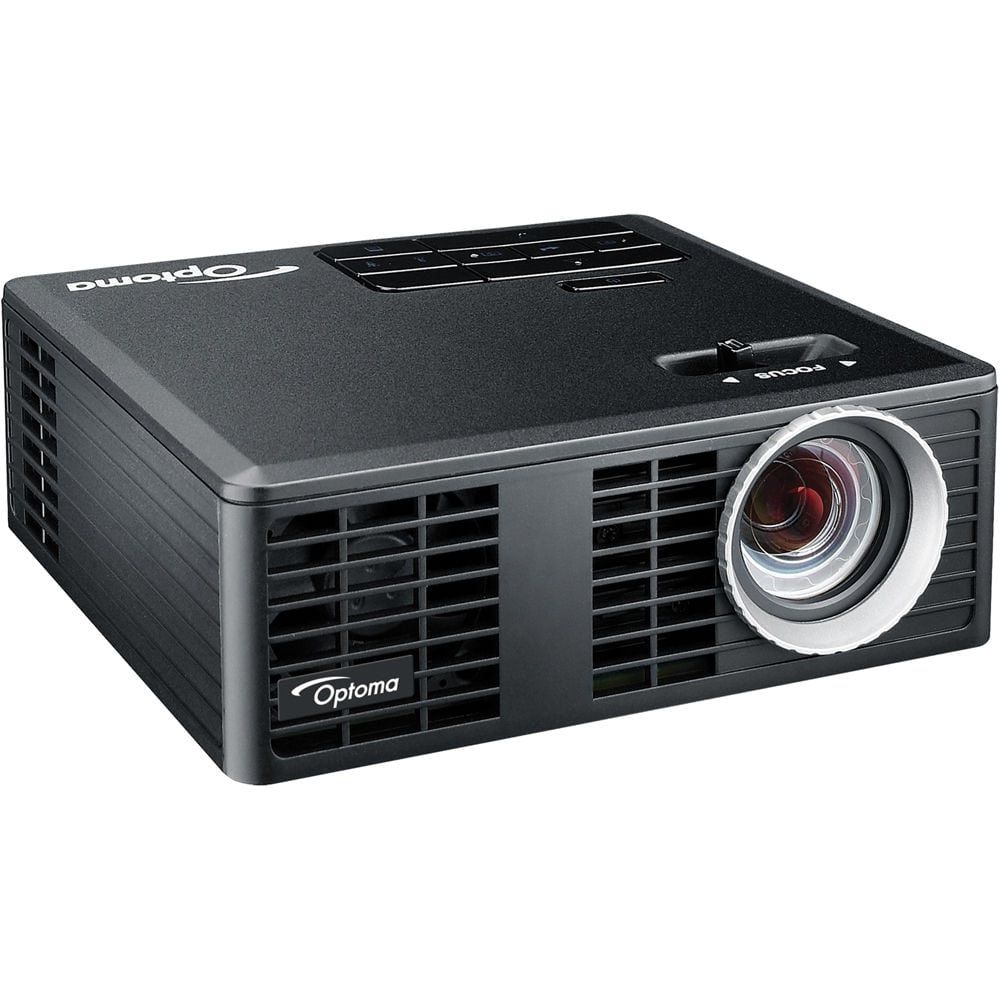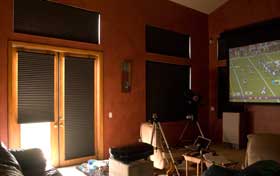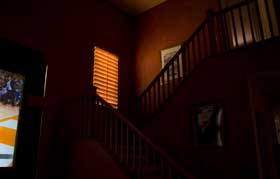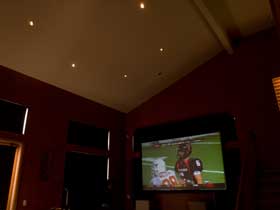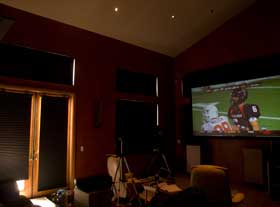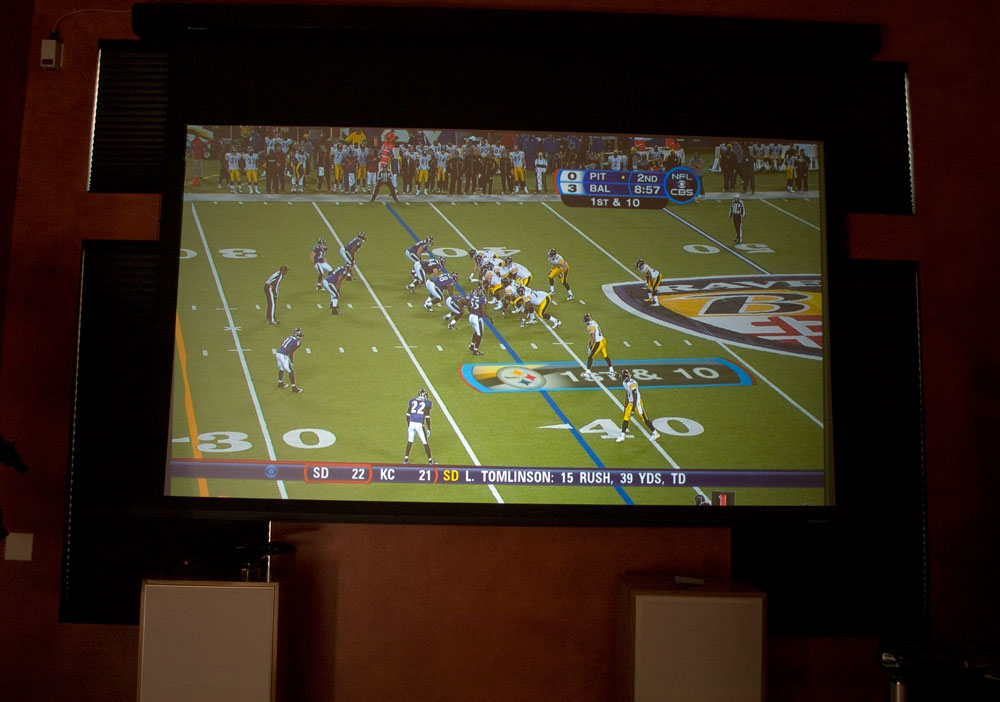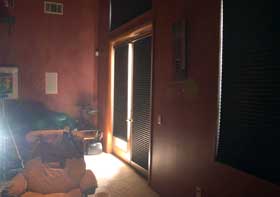Panasonic PT-AE4000 Projector - Image Quality
Panasonic PT-AE4000 images below are from either Blu-ray, or HDTV, with the exception of Lord of the Rings (standard DVD).
These images are provided to support the commentary. In reality, the projectors always look better than the images in our reviews. From a color standpoint, my dSLR camera still adds a very slight green shift to some photo shoots that I have not been able to completely remove. In other words, while we can demonstrate differences in black levels and shadow details of the PT-AE4000, the photos are only approximations of skin tone and color accuracy.
PT-AE4000 Out of the Box Picture Quality
Panasonic PT-AE4000 images below are from either Blu-ray, or HDTV, with the exception of Lord of the Rings (standard DVD).
These images are provided to support the commentary. In reality, the projectors always look better than the images in our reviews. From a color standpoint, my dSLR camera still adds a very slight green shift to some photo shoots that I have not been able to completely remove. In other words, while we can demonstrate differences in black levels and shadow details of the PT-AE4000, the photos are only approximations of skin tone and color accurac
- See more at: https://www.projectorreviews.com/panasonic/panasonic-pt-ae4000-projector-image-quality/?preview=true&preview_id=8400&preview_nonce=2df57b974a#sthash.T7vJ1wyN.dpuf
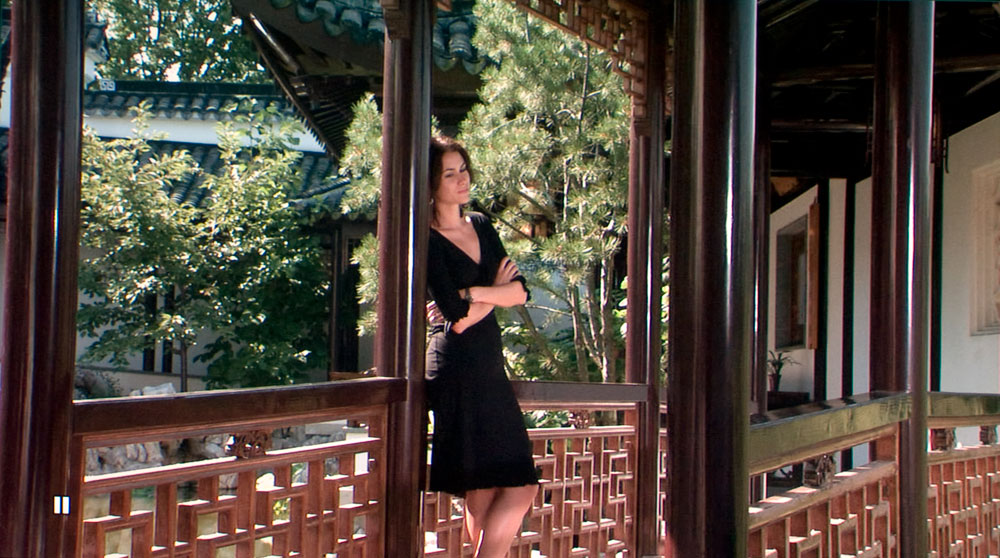 Click Image to Enlarge
Click Image to EnlargeFlesh Tones
After Mike's calibration, skin tones were really very good, but there remained a touch of red push. I'm talking very minor, but it looks that, perhaps due to their new warmer color lamp design. Mike indicated that to remove that last bit, would require calibrating the individual colors, which we normally don't do.
Believe me, the picture and skin tones look just fine. I'm just nitpicking a bit.
Here, first are a pair of images from my favorite movie not available yet on Blu-ray: Lord of the Rings, played from standard DVD. (Note; all these photos show a bit more red than the projector itself does.)
Next are our usual three images of Daniel Craig, as Bond, in Casino Royale, under different lighting conditions. The point here, is that correct skin tones vary, depending on the lighting. You can expect significantly different looking skin tones, when switching from bright sunlight, to nighttime, fluorescent lighting, incandescent lighting, or even lighting in the shade, or a cloudy day. Consider these three images, the first in direct sunlight, the second is a scene with fluorescent lighting, and the third, a sunny day, but Bond is sitting in the shade - indirect lighting.
Next are images from the sci-fi flick, Aeon Flux: (not ready yet. these are placeholders)
Hey, all these staid images, so conservative. It's time for ProjectorReviews.com to get a bit risque, with this image from Quantum of Solace. Afterall, it does have some great skin tones:
Lau, above, from The Dark Knight looks, just a touch too red to be fully believable/natural, but still looked good.
Bottom line on skin tones: The PT-AE4000 really produces fairly rich, natural looking skin tones. Just stay away from using too much of the Panny's dynamic sharpening and contrast controls, as they will take their toll. The PT-AE4000 seems to be one of those projectors that really is fairly "invisible" and doesn't seem to impart any strong characteristics on the image. And that, folks, is a very good thing.
PT-AE4000 Black Levels & Shadow Detail
Shadow Detail Performance
The Panasonic PT-AE4000, as mentioned, tends to crush dark shadow detail, right out of the box with the default settings. Just lifting the brightness a little, makes a big difference. When you have the brightness correct (settings listed in the calibration page), the PT-AE4000 is excellent at shadow detail in almost all situations. (Those dynamic controls for sharpening, detail, contrast, etc., will take their toll on shadow detail.)
If there's one area where the Panasonic is definitely superior to the Epson, it has to be shadow detail.
Below are groups of images, showing the Panasonic's performance on shadow detail and black levels compared to many of the other 1080p projectors out there.
The first set of comparison images is from Space Cowboys. This is a very dark scene with Clint Eastwood, on Blu-ray disc. The photos are intentionally way overexposed. Look for the blacks in the shades, and the details in those shades in the form of the white trim. (At this level of overexposure, don't even worry about the skin tones, as in these types of overexposed photos they always look terrible).
First image is the PT-AE4000, followed by the Sanyo PLV-Z3000 and the Mitsubishi HC7000. Next comes the JVC DLA-RS25. The last two in the sequence are the older Panasonic PT-AE3000 and the new Epson Home Cinema 8500UB.
Again, from Space Cowboys, this is a cropped image. The right side is very bright (so dynamic irises will not be effective). The PT-AE4000 (top left) shows extremely good shadow detail in the dark areas of the satellite, and that's despite the blacks and near blacks being so dark. Next to it on the first row, is the Epson Home Cinema 8500UB/Pro Cinema 9600UB, Those images are followed by the Optoma HD806 and the JVC RS25 (second row). The third row is the Mitsubishi HC7000 (left), and the Sony VPL-HW15. NOTE, - sorry, this Panasonic image is not yet in place (I'm looking for it). A JVC RS25 image is holding the top left spot below.
Next is a frame from the last Indiana Jones movie. You'll this one in other recent reviews. The details still found as the walls and fixtures darken toward the top, are a good way to compare shadow detail.
On the left, is the PT-AE4000, the middle, the Epson 8500UB/9500UB, and on the right, the older Panasonic PT-AE3000. The exposures are all a little different, but you should be able to appreciate the combination of shadow detail and dark blacks
Down below is a night shot of a building, overexposed.
When comparing, look at the detail in the roof (tiles), and also in the assorted trees and plants. The small images below (all from the same projector) show a slightly overexposed scene. Click on the images and you will find larger images, but of the different projectors. The large images are far more overexposed, to allow a closer inspection of shadow details. Note, it's not about how bright the roof tiles are, but that they are visible, and that there are also differences in the trees and shrubs.
Below is a heavily overexposed scene from Lord of the Rings. The overexposure lets you see all the details in the shed on the right, the structure on the left, and the plants and ground along the lower right. The PT-AE4000U performs extremely well, with very good dark detail visible in the structures.
Click on left thumbnail image for the Panasonic PT-AE4000, Epson Home Cinema 6500 UB in the center, and the right for the PT-AE3000U.
Our last comparison uses the night train scene from Casino Royale. Look to the trees and shrubs on the right, especially just above the tracks. The first image is the Panasonic PT-AE4000, the second is the JVC RS25, third is the Epson Home Cinema 8500UB, and finally, the Mitsubishi HC7000.
Next is a side by side - PT-AE4000 as usual is on the Right. the Epson to the Left. This scene is from the trailer of the recent Star Trek movie directed by J.J. Abrams.
Shadow Detail Performance
Overall Color & Picture Quality
Subtle! The Panasonic doesn't jump out at you with an especially dynamic or rich look, rather it has more of that - "it looks right" kind of look. Other than that tinge of too much red in skin tones and elsewhere, the color is truly excellent, and a more thorough calibration should handle that.
For the casual viewer, the Panasonic is just going to look great. And that would even occur with the default settings, although the calibration settings we provide should result in visible improvement.
As seems to be the annual judgement, this year's Panasonic is just a tad more natural, than the Epson Home Cinema 8500UB, though not really in color accuracy, just overall. The Epson has that slightly more dynamic look, a little more pop, that I, and many like, especially since neither projector is extremely bright in best mode.
The Panasonic picture is extremely well balanced, there really is nothing to offend, at all. The overall picture is very well mannered. On typical daylight type scenes the PT-AE4000 looks extremely good, with a healthy amount of pop to the image. The same is pretty much true of most mixed brightness scenes.
Get into the dark scenes, and, with the Panasonic's really excellent black level performance, they too look pretty good. Please realize I'm coming off reviewing two of the most formidable projectors on the market, when it comes to black levels. And this is as good a place as any to try to establish some perspective.
I'm talking about the JVC and the Epson. Well, the JVC is by far the best at dark scenes, especially if there are small amounts of bright areas. It's black are noticeable blacker, and it doesn't compress the bright areas (as projectors using dynamic irises do). The Epson also can produce a noticeably blacker black than the Panasonic, but still closer to the Panny than the JVC, and it does make a difference on those dark scenes like the Bond train scene, or many nighttime or space scenes. The Epson definitely does better than the Panasonic on those scenes, although the JVC is easily superior to both.
Above is the Epson (left) and the Panasonic (right) with this overexposed image of the re-entry scene from Space cowboys. This image serves well for both shadow detail, and blacks. Note the Panasonic is revealing a bit more detail in the lower right portion of the moon, while the Epson is maintaining blacker blacks, and it's image has a touch more pop.
Since we're establishing some perspective, let's also consider two more projectors - a couple of less expensive ones - the lower cost Epson, and the Mitsubishi HC3800, in terms of blacklevels. When we talk about the difference between the Panasonic and Epson, it is slight, relative to a comparison of the Panasonic to the less expensive Epson or the HC3800 by Mitsubishi. Those are "regular" contrast projectors by comparison, and their blacks are much lighter gray than the Panasonic or Epson. They are in a different class. We enthusiasts will all want to make the step up to the ultra-high contrast projectors like the Panasonic, the Epson 8500UB, the Sanyo PLV-Z3000, etc., while most folks will get along just fine with projectors with lesser black performance.
A mix of additional images to show off the PT-AE4000: August Rush
From the DVE-HD test disc:
Back to movies - here's a couple from Dogma and one from Aeon Flux:
And here are a few more images, the two from Dark Knight, followed by two from the movie August Rush, plus a few assorted scenes from movies and digital video sources:
The very bottom line on the overall image quality and color of the Panasonic PT-AE4000: Very pleasing to watch. Natural skin tones, extremely good black levels and shadow detail. Excellent on just about everything, but the darker scenes, where it still performs very well.
Panasonic PT-AE4000U Projector: Performance, HDTV and Sports
Mike made some basic changes - what we call a "quick-cal" to improve color accuracy and picture quality of the Dynamic mode. The resulting quality was pretty good - no match for best mode, but it didn't have any great color shifts and looked just fine watching hours and hours of football. Not as good as a calibrated "best" mode, but more than good enough for sports.
The picture is pretty good. The primary limitation is brightness. Overall, he picture was definitely heavy in greens (very typical for brightest modes). No question, I favor the Epson Home Cinema 8500UB for sports. It's got about 25% more lumens which really helps, and has a more dynamic look , and a bit more accurate color as well. Putting Epson's LivingRoom/CinemaDay more up against Panasonic's dynamic, the Epson has about the same lumens but much better color. If you were marginal with the Panasonic - in terms of image and screen size, then in brightest mode, the Epson is a step brighter, getting your from, say, where the Panny might be "marginal" and the Epson "pretty good".
Lumens aside, I watched quite a bit of football on it this past week. The picture was just fine but for the strong greens, still very watchable, and those greens do help cut through the ambient light! You won't mind the green boost when you need every lumen.
And when I didn't feel the burning need to leave the shades on my doors partially open, thus a darker room, the Panasonic looked even better dropping down to the Normal setting, which gives up a couple hundred or so lumens, but has pretty good color accuracy.
I did virtually all my sports viewing with the CFI set to Mode 1 (the least processing). it definitely was helping out, especially when the cameras are panning. I liked using it, and likely would have it on, for all sports viewing.


